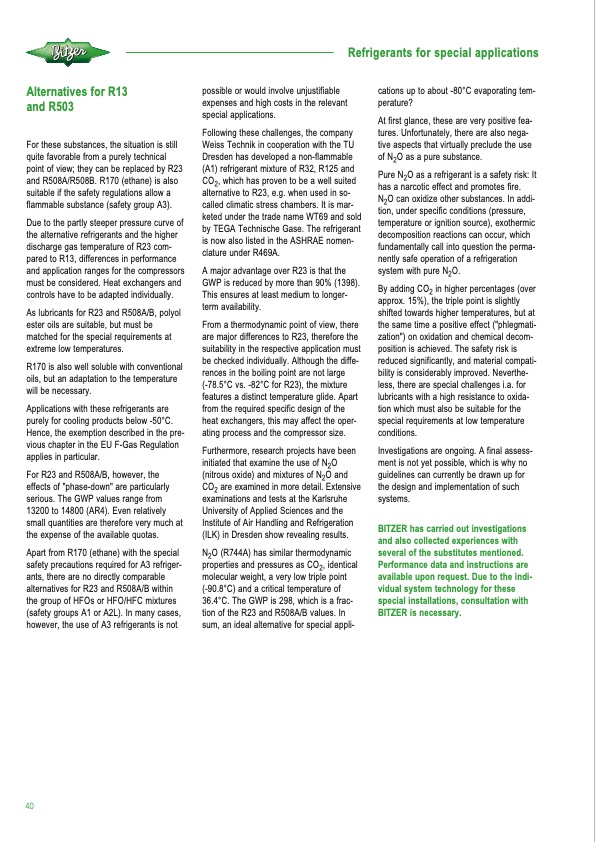
PDF Publication Title:
Text from PDF Page: 040
Refrigerants for special applications Alternatives for R13 and R503 For these substances, the situation is still quite favorable from a purely technical point of view; they can be replaced by R23 and R508A/R508B. R170 (ethane) is also suitable if the safety regulations allow a flammable substance (safety group A3). Due to the partly steeper pressure curve of the alternative refrigerants and the higher discharge gas temperature of R23 com- pared to R13, differences in performance and application ranges for the compressors must be considered. Heat exchangers and controls have to be adapted individually. As lubricants for R23 and R508A/B, polyol ester oils are suitable, but must be matched for the special requirements at extreme low temperatures. R170 is also well soluble with conventional oils, but an adaptation to the temperature will be necessary. Applications with these refrigerants are purely for cooling products below -50°C. Hence, the exemption described in the pre- vious chapter in the EU F-Gas Regulation applies in particular. For R23 and R508A/B, however, the effects of "phase-down" are particularly serious. The GWP values range from 13200 to 14800 (AR4). Even relatively small quantities are therefore very much at the expense of the available quotas. Apart from R170 (ethane) with the special safety precautions required for A3 refriger- ants, there are no directly comparable alternatives for R23 and R508A/B within the group of HFOs or HFO/HFC mixtures (safety groups A1 or A2L). In many cases, however, the use of A3 refrigerants is not possible or would involve unjustifiable expenses and high costs in the relevant special applications. Following these challenges, the company Weiss Technik in cooperation with the TU Dresden has developed a non-flammable (A1) refrigerant mixture of R32, R125 and CO2, which has proven to be a well suited alternative to R23, e.g. when used in so- called climatic stress chambers. It is mar- keted under the trade name WT69 and sold by TEGA Technische Gase. The refrigerant is now also listed in the ASHRAE nomen- clature under R469A. A major advantage over R23 is that the GWP is reduced by more than 90% (1398). This ensures at least medium to longer- term availability. From a thermodynamic point of view, there are major differences to R23, therefore the suitability in the respective application must be checked individually. Although the diffe- rences in the boiling point are not large (-78.5°C vs. -82°C for R23), the mixture features a distinct temperature glide. Apart from the required specific design of the heat exchangers, this may affect the oper- ating process and the compressor size. Furthermore, research projects have been initiated that examine the use of N2O (nitrous oxide) and mixtures of N2O and CO2 are examined in more detail. Extensive examinations and tests at the Karlsruhe University of Applied Sciences and the Institute of Air Handling and Refrigeration (ILK) in Dresden show revealing results. N2O (R744A) has similar thermodynamic properties and pressures as CO2, identical molecular weight, a very low triple point (-90.8°C) and a critical temperature of 36.4°C. The GWP is 298, which is a frac- tion of the R23 and R508A/B values. In sum, an ideal alternative for special appli- cations up to about -80°C evaporating tem- perature? At first glance, these are very positive fea- tures. Unfortunately, there are also nega- tive aspects that virtually preclude the use of N2O as a pure substance. Pure N2O as a refrigerant is a safety risk: It has a narcotic effect and promotes fire. N2O can oxidize other substances. In addi- tion, under specific conditions (pressure, temperature or ignition source), exothermic decomposition reactions can occur, which fundamentally call into question the perma- nently safe operation of a refrigeration system with pure N2O. By adding CO2 in higher percentages (over approx. 15%), the triple point is slightly shifted towards higher temperatures, but at the same time a positive effect ("phlegmati- zation") on oxidation and chemical decom- position is achieved. The safety risk is reduced significantly, and material compati- bility is considerably improved. Neverthe- less, there are special challenges i.a. for lubricants with a high resistance to oxida- tion which must also be suitable for the special requirements at low temperature conditions. Investigations are ongoing. A final assess- ment is not yet possible, which is why no guidelines can currently be drawn up for the design and implementation of such systems. BITZER has carried out investigations and also collected experiences with several of the substitutes mentioned. Performance data and instructions are available upon request. Due to the indi- vidual system technology for these special installations, consultation with BITZER is necessary. 40PDF Image | REFRIGERANT REPORT 21

PDF Search Title:
REFRIGERANT REPORT 21Original File Name Searched:
A-501-21_EN.pdfDIY PDF Search: Google It | Yahoo | Bing
CO2 Organic Rankine Cycle Experimenter Platform The supercritical CO2 phase change system is both a heat pump and organic rankine cycle which can be used for those purposes and as a supercritical extractor for advanced subcritical and supercritical extraction technology. Uses include producing nanoparticles, precious metal CO2 extraction, lithium battery recycling, and other applications... More Info
Heat Pumps CO2 ORC Heat Pump System Platform More Info
| CONTACT TEL: 608-238-6001 Email: greg@infinityturbine.com | RSS | AMP |